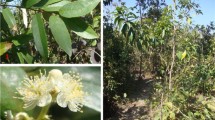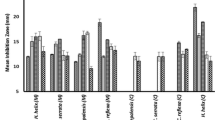Although lichen species are a good source of bioactive compounds having medicinal importance, the biological potential of the Lichens in Kashmir region is still unexplored. The current study was designed to investigate the antimicrobial potential of various solvent extracts of 12 lichen species against pathogenic bacterial strains including Pseudomonas aeruginosa, Escherichia coli, Staphylococcus aureus, Klebsilla species along with a fungal pathogen Aspergillus. The disc diffusion method was used to determine the antimicrobial potential of bacterial and fungal strains. The result of the present study revealed that the acetone extract of Evernia species showed the highest antibacterial activity, whereas E. coli, P. aeruginosa and S. aureus were found to be the highly sensitive bacterial strains affected by the lichen species Evernaia mesomorpha, Evernia prunistri and Ramalina fraxinea respectively. The highest zone of inhibition was shown by Parmilia sulcata (28.60 ± 0.33), Evernia mesomorpha (18.33 ± 0.89) and Sticta lambata (18 ± 0.58) followed by Usnea subfloridiana (17 ± 0.58) Collema furfuraceum (16.67 ± 0.33) and Pheophysia (16 ± 0.58) against the fungal strain. FTIR spectrum confirmed the presence of natural bioactive compounds including phenols, alkanes, alkynes, alkyl halides, aldehydes, carboxylic acids, aromatics nitro compounds and amines. Results suggest that the investigated lichens species could serve assignificantt antimicrobial agents against multi-drug resistance pathogenic bacteria and fungi.





Similar content being viewed by others
References
C. S. Bezivin, Tomasi, I. Rouaud, J. G. Delcros, et al., Plant Med., 70, 874 – 877(2004).
B. M. Rankovic, Misic, S. Sukdolak, J. Biomed Sci., 64(4), 143 – 183 (2007).
T. E. Kristmundosdottir, Jonsdottir, H. M. Ogmundstottir, et al., J. Pharmacol. Sci., 24, 539 – 543 (2005).
B. D. Rankovic, D. Maric. Microbiol., 79(6), 809–815 (2009).
B. R. Rankovic, M. M. Kosanic, T. P. Stanojkovic, BMC Complement. Altern. Med., 11, 97 – 104 (2011).
A. K. Sharma, M. C. Sharma1, M. P. Dobhal, J. Nat. Prod. Plant Resour., 2(1), 101 – 106 (2012).
A. Karagoz, N. Doruoz, Z. Zeybek, A. Aslan, J. Medi. Plants Res., 3(12), 1034 – 1039 (2009).
A. Dieua, L. Mambu, Y. Champavier, et al., Nat. Prod. Res., 34(23), 3358–3362 (2020); https://doi.org/10.1080/14786419.2018.1561678.
A.W. Bauer,W.M.M. Kirby, J. C. Sherris, M. A. Turck, J. Clin. Pathol., 45, 493–496 (1966); https://doi.org/10.1093/ajcp/45.4ts.493.
A. Aslan, M. Gulluce, M. Sokmen, et al., Pharm Biol., 44, 247 – 252 (2006).
A. Adedapo, F. O. Jimoh, S. Koduru, et al., Alt. Med., 8, 1 – 53 (2008).
M. Kosanic, R. Branislav, J. Sci., 32, 65 – 72 (2010).
P. Prateeksha, B. S. Paliya, R. Bajpai, et al., RSC Adv., 6(26), 21672–21696 (2016); https://doi.org/10.1039/C5RA24205C.
K. Marijana, R. Branislav, S. Slobodan, African J. Microbio. Res., 4(9), 885 – 890 (2010).
N. T. Manojlovic, S. Solujic, S. Sukdolak, et al., Fitoterapia, 76, 244 – 246 (2005).
T. L. Mitrovic, S. M. Stamenkovic, V. J. Cvetkovic, et al., Oxid. Commun., 38(4A) (2016).
T. Mitrovic, S. Stamenkovic, V. Cvetkovic, et al., Int. J. Mol. Sci., 12(8), 5428–5448 (2011).
S. Sasidharan, Y. Chen, D. Saravanan, et al., Afr. J. Tradit. Complement Altern. Med., 8(1), 1 – 10 (2011).
M. Candan, M. Yýlmaz, T. Tay, Zeitschrift Fur Naturforsch C, 62(7–8), 619–621 (2007).
A. A. Agboke, C. O. Esimone, J. Med. Plants Res., 5(4), 644 – 648 (2011).
M. J. Ahmed, G. Murtazaa, F. Rashid, et al., Drug Develop. Ind. Pharm., 45(10), 1682–1694 (2019).
P. Dzomba, E. Togarepi, C. Musekiwa, African J. Biotech., 11(31), 7995 – 7999 (2012).
Author information
Authors and Affiliations
Corresponding author
Rights and permissions
Springer Nature or its licensor (e.g. a society or other partner) holds exclusive rights to this article under a publishing agreement with the author(s) or other rightsholder(s); author self-archiving of the accepted manuscript version of this article is solely governed by the terms of such publishing agreement and applicable law.
About this article
Cite this article
Khan, S., Firdous, S.S., Shaheen, H. et al. Antimicrobial Activities of Medicinally Important Lichen Extracts Against Human Pathogenic Bacteria and Fungi. Pharm Chem J 57, 1469–1475 (2023). https://doi.org/10.1007/s11094-023-03012-x
Received:
Published:
Issue Date:
DOI: https://doi.org/10.1007/s11094-023-03012-x




